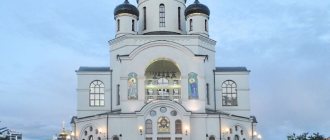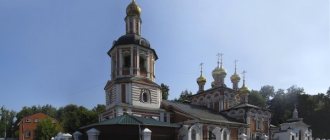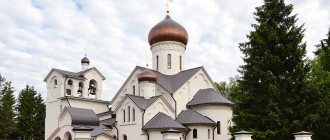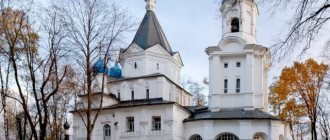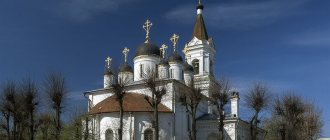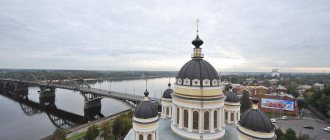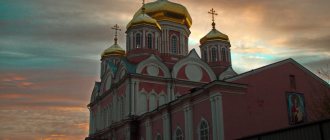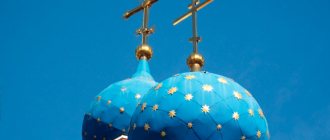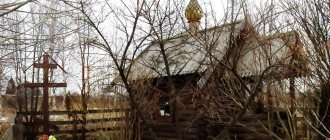Mir
Russia Moscow Church of the Life-Giving Trinity in Ostankino (Moscow) Map is loading…
{"format":"leaflet","minzoom":false,"maxzoom":false,"limit":50,"offset":0,"link":"all","sort":[""], "order":[],"headers":"show","mainlabel":"","intro":"","outro":"","searchlabel":"\u2026 \u0441\u043b\u0435\ u0434\u0443\u044e\u0449\u0438\u0435 \u0440\u0435\u0437\u0443\u043b\u044c\u0442\u0430\u0442\u044b","default":"","import-annotation":false,"width ":"auto","height":"350px","centre":{"text":"","title":"""link":"""lat":55.82410829999999890560502535663545131683349609375,"lon": 37.61361670000000145819285535253584384918212890625,"icon":""},"title":"","label":"","icon":"","lines":[],"polygons":[],"circles":[ ],"rectangles":[],"copycoords":false,"static":false,"zoom":8,"defzoom":14,"layers":["OpenStreetMap"],"image layers":[] ,"overlays":[],"resizable":false,"fullscreen":true,"scrollwheelzoom":true,"cluster":false,"clustermaxzoom":9,"clusterzoomonclick":true,"clustermaxradius":80, "clusterspiderfy":true,"geojson":"","clicktarget":"","showtitle":true,"hidenamespace":false,"template":"","userparam":"","activeicon": "","pagelabel":false,"ajaxcoordproperty":"","ajaxquery":"","locations":[{"text":"\u003Cb\u003E\u003Ca href=\"/palomnik/%D0% A5%D1%80%D0%B0%D0%BC_%D0%A2%D1%80%D0%BE%D0%B8%D1%86%D1%8B_%D0%96%D0%B8%D0%B2% D0%BE%D0%BD%D0%B0%D1%87%D0%B0%D0%BB%D1%8C%D0%BD%D0%BE%D0%B9_%D0%B2_%D0%9E%D1% 81%D1%82%D0%B0%D0%BD%D0%BA%D0%B8%D0%BD%D0%BE_(%D0%9C%D0%BE%D1%81%D0%BA%D0%B2 %D0%B0)\" title=\"\u0425\u0440\u0430\u043c \u0422\u0440\u043e\u0438\u0446\u044b \u0416\u0438\u0432\u043e\u043d\u0430\u0447\u0430\ u043b\ u044c\u043d\u043e\u0439 \u0432 \u041e\u0441\u0442\u0430\u043d\u043a\u0438\u043d\u043e (\u041c\u043e\u0441\u043a\u0432\u0430)\ »\u003E\u0425\u0440\ u0430\u043c \u0422\u0440\u043e\u0438\u0446\u044b \u0416\u0438\u0432\u043e\u043d\u0430\u0447\u0430\u043b\u044c\u043d\u043e\u0 439\u0432\u041e\u0441\u0442\ href= \"/palomnik /%D0%A1%D0%B2%D0%BE%D0%B9%D1%81%D1%82%D0%B2%D0%BE:%D0%90%D0%BD%D0%BD%D0%BE %D1%82%D0%B0%D1%86%D0%B8%D1%8F\" title=\"\u0421\u0432\u043e\u0439\u0441\u0442\u0432\u043e:\u0410\u043d\u043d\ u043e\u0442\u0430\u0446\u0438\u044f\»\u003E\u0410\u043d\u043d\u043e\u0442\u0430\u0446\u0438\u044f\u003C/a\u003E: \u043f\u043 0\u043c\u044f\u0442 \u043d\u0438\u043a \u0441\u0442\u0430\u0440\u043e\u0440\u0443\u0441\u0441\u043a\u043e\u0433\u043e \u043a\u0443\u043b\u044c\ u0442\u043e\u0432\u043e\u0433 \u043e \u0437\u043e\u0434\u0447\u0435\u0441\u0442\u0432\u003Cspan class=\»smw-highlighter\» data-type=\»2\» data-state=\»persistent\» data-title =\"\u0418\u043d\u0444\u043e\u0440\u043c\u0430\u0446\u0438\u044f\" title=\"\u043f\u0430\u043c\u044f\u0442\u043d\u0438\u043a\u0441 \u0442\ u0430\u0440\u043e\u0440\u0443\u0441\u0441\u043a\u043e\u0433\u043e \u043a\u0443\u043b\u044c\u0442\u043e\u0432\u043e\u0433\u04 3e\u0437\u043e\u0434\u0447\ u0435\u0441\u0442\u0432\u0430 \u043a\u043e\u043d\u0446\u0430 XVII \u0432\u0435\u043a\u0430, \u043e\u0434\u043d\u0430 \u0438\u04 37\u043a\u0443\u043b\u044c\ u043c\u0438\u043d\u0430\u0446\u0438\u043e\u043d\u043d\u044b\u0445 \u0442\u043e\u0447\u0435\u043a \u0432 \u0440\u0430\u0437\u 0432\u0438\u0442\u0438\u0438\ u043c\u043e\u0441\u043a\u043e\u0432\u0441\u043a\u043e\u0433\u043e \u0443\u0437\u043e\u0440\u043e\u0447\u044c\u044f. \u0425\u0440\u0430\u043c \u0432\u0445\u043e\u0434\u0438\u0442 \u0432 \u043a\u043e\u043c\u043f\u043b\u0435\u043a\u0441 \u043 f\u0430\u043c\u044f\u0442\u043d \u0438\u043a\u043e\u0432 \u043c\u0443\u0437\u0435\u044f-\u0443\u0441\u0430\u0434\u044c\u0431\u044b \u00ab\u041e\u0441\u0442\ u0430\u043d\u043a\u0438\ u043d\u043e\u00bb. \u0417\u0434\u0430\u043d\u0438\u0435 \u0445\u0440\u0430\u043c\u0430 \u043e\u0442\u043d\u0435\u0441\u0435\u043d\u043e \u043a \u043a\u0430\u0442\u0435\u0433 \u043e\u0440\u0438\u0438 \u043e\u0431\u044a\u0435\u043a\u0442\u043e\u0432 \u043a\u0443\u043b\u044c\u0442\u0443\u0440\u043d\ u043e\u0433\u043e\u043d\u0430 \u0441\u043b\u0435\u0434\u0438\u044f \u0444\u0435\u0434\u0435\u0440\u0430\u043b\u044c\u043d\u043e\u0433\u043e \u0437\u043d\ u0430\u0447\u0435\u043d\u0438 \u044f.\"\u003E\u003Cspan class=\"smwtext\"\u003E \u2026 \u003C/span\u003E\u003Cspan class=\"smwttcontent\"\u003E\u043f\u0430\u043c\u044f\u0442\u043 d\ u0438\u043a\u0441\u0442\u0430\u0440\u043e\u0440\u0443\u0441\u0441\u043a\u043e\u0433\u043e\u043a\u0443\u043b\u044c\u0442\u0 43e\u0432\u043e\u0433\u043e\ u0437\u043e\u0434\u0447\u0435\u0441\u0442\u0432\u0430 \u043a\u043e\u043d\u0446\u0430 XVII \u0432\u0435\u043a\u0430, \u043e\u043 4\u043d\u0430\u0438\u0437\ u043a\u0443\u043b\u044c\u043c\u0438\u043d\u0430\u0446\u0438\u043e\u043d\u043d\u044b\u0445 \u0442\u043e\u0447\u0435\u043a\u0 432\u0440\u0430\u0437\u0432\ u0438\u0442\u0438\u0438 \u043c\u043e\u0441\u043a\u043e\u0432\u0441\u043a\u043e\u0433\u043e \u0443\u0437\u043e\u0440\u043e\u0 447\u044c\u044f. \u0425\u0440\u0430\u043c \u0432\u0445\u043e\u0434\u0438\u0442 \u0432 \u043a\u043e\u043c\u043f\u043b\u0435\u043a\u0441 \u043 f\u0430\u043c\u044f\u0442\u043d \u0438\u043a\u043e\u0432 \u043c\u0443\u0437\u0435\u044f-\u0443\u0441\u0430\u0434\u044c\u0431\u044b \u00ab\u041e\u0441\u0442\ u0430\u043d\u043a\u0438\ u043d\u043e\u00bb. \u0417\u0434\u0430\u043d\u0438\u0435 \u0445\u0440\u0430\u043c\u0430 \u043e\u0442\u043d\u0435\u0441\u0435\u043d\u043e \u043a \u043a\u0430\u0442\u0435\u0433 \u043e\u0440\u0438\u0438 \u043e\u0431\u044a\u0435\u043a\u0442\u043e\u0432 \u043a\u0443\u043b\u044c\u0442\u0443\u0440\u043d\ u043e\u0433\u043e\u043d\u0430 \u0441\u043b\u0435\u0434\u0438\u044f \u0444\u0435\u0434\u0435\u0440\u0430\u043b\u044c\u043d\u043e\u0433\u043e \u0437\u043d\ u0430\u0447\u0435\u043d\u0438 » u0435\u0434\u0438\ u044f\u0444\u0435\u0434\u0435\u0440\u0430\u043b\u044c\u043d\u043e\u0433\u043e\u0437\u043d\u0430\u0447\u0435\u043d\u0438\u0 44f.","title":"\ u0425\u0440\u0430\u043c \u0422\u0440\u043e\u0438\u0446\u044b \u0416\u0438\u0432\u043e\u043d\u0430\u0447\u0430\u043b\u044c\u0 43d\u043e\u0439 \u0432 \u041e\ u0441\u0442\u0430\u043d\u043a\u0438\u043d\u043e (\u041c\u043e\u0441\u043a\u0432\u0430)»»link»:»»»lat»:55.8241082999999989056050253 5663545131683349609375,"lon":37.61361670000000145819285535253584384918212890625, "icon":""}],"imageLayers":[]}
55.824051; 37.61362
Russia, Moscow, 1st Ostankinskaya street, 7с2
Moscow
Russia
Telephone:
(495) 686-32-23; fax: (495) 616-50-05
Church phone number:
(495) 602-23-28
Church of the Life-Giving Trinity in Ostankino
- a monument of Old Russian religious architecture of the late 17th century, one of the culminating points in the development of Moscow pattern making. The temple is part of the complex of monuments of the Ostankino museum-estate. The temple building is classified as a cultural heritage site of federal significance.
Address of the Church of the Life-Giving Trinity in Ostankino
The Church of the Life-Giving Trinity in Ostankino is located on 1st Ostankinskaya street, building 7, building 2.
How to get there by car
By personal car from the center you can go along Mira Avenue to Ostankino Proezd, then along 1st Ostankinskaya Street to the church building. Or another option is along Sheremetyevskaya Street to Argunovskaya, then along Akademika Korolev to Novomoskovskaya, and then along 1st Ostankinskaya Street to the church itself.
From VDNKh along Akademika Korolev Street to the arrow at the 4th traffic light, turn right to 1st Ostankinskaya Street, then at the intersection turn left at the traffic light, and straight ahead 400 m.
How to get there by public transport
The most convenient and easiest way is to get to the station by metro:
- Telecentre distance is 660 m, 10 min walk;
- Academician Korolev Street is a little further, 860 m;
- VDNKh distance is 1.5 km, you can walk it in about 30 minutes. on the street Academician Korolev towards the TV tower, then right along Novomoskovskaya Street, and left along 1st Ostankinskaya to the goal. This route can be shortened a little by taking bus No. 76 or 803 to the rehabilitation center stop, or by tram No. 11 or 17 to the Ostankino stop. You can also take trolleybus No. 9, 13, 36, 37, 69 or 73 to the Akademika Koroleva Street stop.
There is an option to travel by high-speed train in 7 minutes. by monorail from the Exhibition Center to the television center stop, but the train interval is 20 minutes.
History of the temple
The Church of the Life-Giving Trinity in Ostankino was erected more than 300 years ago with the blessing of the Moscow Patriarch Iakim, given to the owner of the estate, Prince Mikhail Cherkassky, for the construction of a stone building, instead of a wooden rural church.
The estate in Ostankino at that time was the main residence of the large Cherkasy landowners near Moscow, who owned more than 9 thousand peasant households.
The newly built stone patterned church in the immediate vicinity of the manor house was used as a home church. The northern border was consecrated in 1683 in honor of the Tikhvin Icon of the Mother of God, 8 years later the southern border was consecrated in the name of St. Alexander of Svir, and a year later the central border was consecrated in honor of the Life-Giving Trinity.
Later, the estate went as a dowry to Varvara’s daughter to the Sheremetyev princes, who were carrying out work on the reconstruction and expansion of the church building.
The royal people visited the Cherkasy home church many times, stopping for prayer at the estate located on the route to the Trinity-Sergius Lavra:
- Imperial visit of Anna Ioannovna in July 1730;
- Empress Elizaveta Petrovna visited 4 times in 1742;
- There were repeated royal visits from Nicholas I;
- Emperor Alexander II fasted with his family for several days in August 1856.
People of different classes, not excluding many noble persons, strolled with pleasure in the lovely Ostankino groves. A pleasure garden was opened here for public walks with covered gazebos and decorative sculptures.
After the revolution, the poor and small parish moved from the upper altars to the basement, where the 4th limit of St. Nicholas the Wonderworker was consecrated. In the 20s of the 20th century, the temple was in great need. All church utensils, valuables and silver frames with a total weight of over 4 pounds are confiscated from it.
Since 1930, the church has been closed, and the building housed a museum of anti-religious art, which saved the unique structure and some shrines. During the war period it is used as a warehouse and storage for valuable palace property.
The installation of central water heating and a faulty pipeline led to increased humidity in the building, which resulted in the destruction of foundations and walls.
By the 80s, the iconostasis and wall paintings were being restored, and repair work was being carried out on the roof and facades of the building. Concert performances by a chamber ensemble of sacred and secular music of the 17th century are held in the spacious church building.
In 91, the central limit of the Trinity Church was re-lit by Patriarch Alexy II, and the remaining limits were soon restored and consecrated. For quite a long time it was the courtyard of the Optina Pustyn monastery, and today it is the courtyard of the Moscow Patriarch.
History[edit]
More than three hundred years have passed since the moment when Patriarch Joachim of Moscow and All Russia blessed Prince Mikhail of Cherkassy (then owner of the village of Ostankino) to build a new stone church to replace the old wooden one that stood in his village and was consecrated in honor of the Life-Giving Trinity. In the new church, the prince was going to add two chapels in the name of the Most Holy Theotokos, the icon of Tikhvin and St. Venerable. Alexander Svirsky. Prince Cherkassky asked for permission to build the church in a new place, because in the old place in previous years there had been a pestilence, and there were many burials. The petition for the construction of a stone temple was submitted by the prince in September 7186 from the creation of the world (1678 AD).
The village of Ostankino (Ostashkovo on Sukhodol) has been known from written sources since 1548; after the Time of Troubles, this village became the patrimony of Prince Ivan Borisovich Cherkassky. From written documents it follows that in 1617 there was a church in the name of the Life-Giving Trinity, arable land, a pond, a mill, the Boyarkin settlement, a boyar's courtyard, the Kopytenka River (which after 1920 was enclosed in a pipe, and now Zvezdny Boulevard is above it) . The church staff was small: a priest, a sexton for serving at the altar, and a sexton, he was also a bell-ringer and could replace the sexton, a mallow-maker.
In 1625-1627 a new wooden church was built. The estate came into the possession of Prince Yakov Kudentovich Cherkassky, and after his death, Prince Mikhail Yakovlevich Cherkassky began to own the village, who decided to build a new stone one instead of the old, dilapidated wooden church. The eldest son of Prince Peter in 1696 married Princess Marya Borisovna Golitsyna (daughter of the Tsar’s mentor, Prince Golitsyn), and the youngest son married Agrafena Lvovna Naryshkina, daughter of Tsar Peter’s uncle. Prince Cherkassky was the largest landowner; he owned 9,083 households. Ostankino was the main estate of the Cherkasskys near Moscow in the 17th century. Throughout his life, Prince Mikhail Cherkassky built a lot; in 1667 he built a church in the name of St. Nicholas the Wonderworker in the Novo-Spassky Monastery, church in the name of St. Nicholas the Wonderworker with the chapel of St. Alexy, Metropolitan of Moscow in the village of Nikolskoye on the Zinka River (where Khimki is now); a new stone church in the name of the Vladimir Icon of the Mother of God on the territory of the Kremlin; Church of the Life-Giving Trinity in Ostankino; the stone Church of the Nativity of Christ in the village of Ostashkovo on Klyazma; Trinity Ostrovoezersk Monastery in Vorsma; wooden church in the village. Ivani; stone church in Tomsk, where he opened the first brick factories and erected the first stone buildings.
The main residence of the Cherkasskys near Moscow was Ostankino. Just a mile away from it was the Trinity Road, which led to the Lavra of St. Sergius, and the royal village of Alekseevo. The new temple, located in close proximity to the estate, was the home church of the Cherkasy family, and had three chapels: the northern chapel, consecrated on February 3, 1683 in the name of the Tikhvin Icon of the Mother of God, the southern chapel in the name of St. Alexander Svirsky, consecrated on August 1, 1691; the central one is in the name of the Life-Giving Trinity, consecrated on June 3, 1692, the iconostasis dates back to the same year. More than once, noble persons, including members of the royal family, stopped on the way to the Trinity-Sergius Lavra at the Cherkassky estate and prayed in their home church. It is known that in 1856, before the arrival of Emperor Alexander II, “to live in the house of a local owner and worship in the church in the village of Ostankino,” the iconostasis was restored and the icons in it were corrected. The iconostasis of the Church of the Life-Giving Trinity in Ostankino is interesting in that it consists of nine tiers, the frames on the icons are decorated with end-to-end high gilded carvings; columns, intercepted one third from the base by a baroque ring, twisted or entwined with carved vines. In appearance and sound, the iconostasis as a whole resembles an organ - a new instrument unprecedented in Orthodox churches, in which the icon openings are of different sizes in height and length, have different configurations, and none of the rows repeats the other.
In the 18th century, Ostankino continued to be the main residence of the Cherkasskys near Moscow. But with the transfer of the capital to St. Petersburg, the owners did not often visit their estate. However, in the 30s Ostankino regained its former importance. Prince Cherkassky is no longer sent on duty to Siberia, and he spends the summer with his family in Ostankino. In July 1730, while traveling to the Trinity Monastery, Empress Anna Ioanovna visited the Cherkassky estate, and in 1742 (four times: July 10 and 20, September 28 and October 27) Prince Alexei Mikhailovich Cherkassky received Elizabeth Petrovna. The prince died that same year on November 4th. After his death, he left behind his beloved daughter Varvara, chamberlain - maid of honor to Her Imperial Majesty, whom Peter the Great himself taught to shoot a bow, in front of whom she danced a minuet, and whom in January 1743 Princess Marya Yuryevna Cherkasskaya married Count Peter Borisovich Sheremetev . The newlyweds moved to Kuskovo, and Ostankino temporarily plunged into a historical sleep. Until the death of Countess Varvara Alekseevna in 1767, the temple remained intact, since Ostankino and the Trinity Church were shrines to her. But after that, Peter Borisovich changed the appearance of the temple, the iconostasis was resumed, new icons and new shrines appeared. In 1788 the count died, leaving Ostankino to his son Nikolai.
With the advent of the new, 19th century, the Sheremetevs moved to St. Petersburg, where the young countess soon died in childbirth. The inconsolable count donates for the construction of charitable institutions, erects the largest hospice house, in which a huge number of pilgrims could live, eat and receive medical care for three days free of charge (now this is the well-known Sklifosovsky Institute of Emergency Care). Six years later, the count himself dies, the estate is inherited by the prince’s young son Dmitry Nikolaevich, under whom the temple is again repaired, restored, the composition of the iconostasis changes dramatically, and the walls are painted again. The porch was painted in 1851, and the main altar the following year. Ostankino at that time was one of the most charming places in the near Moscow region; people of all ranks and classes loved to stroll in its groves. Since the 30s, the pleasure garden has been open to everyone for walks; outbuildings of various ranks are rented out to Moscow residents for the summer. Count Dimitry Nikolaevich often visits the estate. During one of Emperor Nicholas I’s visits to Ostankino, he, together with the count, was on the balcony of the estate and complained that the grove growing behind the pond interfered with the view of Moscow. On his next visit, the emperor saw from the balcony a clearing with a view of the bell tower of Ivan the Great in the Kremlin. In 1856, Emperor Alexander II, upon his accession to the throne, chose Ostankino as the place for the imperial couple to worship. The entire temple was restored, the icons were corrected, the outer walls and roof were repainted, the paintings on the inner walls were washed, the crosses were gilded. August 18, 1856 The royal family arrived at the temple, a prayer service was heard with the proclamation of many years, the royal persons venerated the cross and were sprinkled with holy water. Then, in deep solitude, through fasting and prayer, the imperial couple prepared for the celebration of coronation and confirmation. On August 25, after listening to the liturgy, the royal family left for Moscow. The next day, the royal wedding took place in the Assumption Cathedral of the Kremlin.
Count Dmitry Sheremetev was pious and poverty-loving, and often attended the worship of shrines. In the summer of 1866, he brought a miraculous image to Ostankino - the Iveron Icon of the Mother of God. A liturgy was served in the church, then the procession with the miraculous icon proceeded to the palace, where a prayer service was served. Then the icon was carried to the homes of local residents; a total of seventeen prayer services took place. On the same day, in the evening, the icon was returned to Moscow.
In 1875, the new owner of the estate, Count Alexander Dmitrievich Sheremetev, allocated work for the repair and external restoration of the temple. The newly discovered forms of architecture and decoration of the church were so liked that it was decided to make detailed drawings and plans of it as a monument of architecture and architecture.
In 1919, the parish, due to poverty and lack of people, was forced to descend from the upper churches to the basement, where the altar was consecrated in the name of St. Nicholas. On April 23, 1922, valuables were confiscated from the temple, and the weight of the frames from the icons and Gospels amounted to 4 pounds 1 pound 12 spools of silver. In the 1920s, the temple suffered extreme need and poverty. Presumably in 1930 the parish was abolished, and the temple came into the possession of the Anti-Religious Museum of Art together with the financial department of the Dzerzhinsky district of Moscow. The Narkompit stored potatoes in the basement of the temple. Since January 1935, the museum took over the temple; the best monuments of the temple were plundered. The church was demonstrated by the museum as an architectural monument of the 17th century. Since the beginning of the Great Patriotic War, the museum was closed; all the most valuable property from the palace was transferred to the temple; Since then, the temple premises served as a storage facility. In the 1970s, restoration of iconostases, murals, and repairs of roofs and facades began. In the 1980s, the church hosted concerts of spiritual and secular music of the 18th century performed by a chamber ensemble.
On March 23, 1991, His Holiness Patriarch of Moscow and All Rus' Alexy II consecrated the throne in honor of the Holy Life-Giving Trinity. On December 31, 1994, Archbishop of Vladimir and Suzdal Evlogy consecrated the southern chapel in the name of St. St. Alexander Svirsky. On August 14, 1996, Archbishop Arseny of Istra consecrated the northern chapel in the name of the Tikhvin Icon of the Mother of God.
For almost nine years, there was a courtyard of the Holy Vvedensky Monastery of Optina Pustyn, and now the Patriarchal courtyard. Over these years, through the labors and prayers of the church’s clergy and its rector, a fairly large Orthodox community was created in the parish.
Architect and Exterior Decoration
The exact authorship of the church building project has not been fully established. It is assumed that the Trinity Church was erected by a serf architect from the Novgorod province Pavel Sidorovich Potekhin, who carried out many orders of Prince Odoevsky, who was Cherkassky’s father-in-law.
Church of the Life-Giving Trinity before and after restoration
His style is characterized by the contrast of a clear and simple geometry of a square plan with a bright picturesque richness of volume; the transitions to the vaults are emphasized by a wide belt and elegant carved cornices.
The external complex and intricate decoration of the facades with tiles is replete with lush decorative elements and ornaments in the style of Moscow patterning. Icons of the Savior, the Mother of God, Nicholas the Pleasant and Jonah the Baptist also decorate the external church walls.
The windows are decorated with multi-profile platbands with openwork carved patterns, stars or crowns. White stone is used in the decoration of the vertical corner blades, which adds exquisite elegance and freshness to the building.
The niches are clearly arranged in 2 rows. Belts of small flies in 4 rows cover the entire perimeter of the quadrangle, including the gallery. The figure-octagon is decorated with the same 2-row belt. The belfry tier with arched openings is lavishly decorated with brick details. The profile kokoshniks are designed in a similar way.
Architectural ensemble
Structurally, the temple is a pillarless quadrangle, typical of that time, with 2 side volumes on a high common plinth (basement). Compositionally, the structure is characterized by strict symmetry. The building is surrounded on 3 sides by a covered gallery. From the west, a bell tower with a hipped roof rises above the porch.
What is original is the absence of a refectory and the isolation of the inner church premises from the main building by piers. The entrance is decorated with a high elegant porch, richly decorated with a tent.
The domes with an increased depth of domes and a reduced width of the base of the drums also add originality to the building. There are 7 domes in total: 5 above the central part and one above each of the limits. The bell selection of 12 unique bells from the 18th – 19th centuries, preserved during the museum period, has now been returned to the church belfry.
The architecture of the temple harmoniously combined the features of different schools of Yaroslavl, Kostroma and Novgorod masters.
Church in Ostankino (Moscow): architecture
According to art historians, the architectural style of this temple belongs to the Moscow pattern. In the external decoration of the church, attention is drawn to the abundance of decorative elements, as well as the general intricacy and complexity of the composition. The facade of the temple is completely covered with patterned tiles.
In terms of the church's plan, its unconventionality is also no less interesting: the complete absence of a refectory, the self-sufficiency of the church aisles, internally separated from the main building by partitions and looking like separate buildings. The design of the temple is represented by a pillarless quadrangle, typical of its time, installed on a fairly high basement, on the sides of which there are identical chapels. There is a walkway on three sides of the temple. With all this originality, the overall composition of the structure is strictly symmetrical. The church porch is covered with a richly decorated tent, the sight of which evokes an association with Yaroslavl patterned architecture.
The real highlight of the interior decoration of the church is its nine-tiered iconostasis, decorated with carved gilded decor depicting twisted grape vines. An unexpected allusion is that its shape resembles an organ, unthinkable in an Orthodox church, but an obligatory participant in all Catholic services. Many Moscow experts call the author of the stone church project the serf architect Pavel Sidorovich Potekhin, whose owner was Prince Cherkassky's father-in-law, Yakov Odoevsky.
Interior decoration
The iconostasis of the church was created at the end of the 17th century, consists of 9 unique rows, looks like an organ, with icon openings of different sizes. The icons are decorated with end-to-end gilded carvings, the columns are decorated with carved baroque rings with twisted grape vines.
The 13.5 m high iconostasis has survived to this day in almost its original form with very minor changes. The lower tier is represented by images of Hellenic sages, who heralded the coming of the Savior with inscriptions on scrolls in their hands.
The upper tiers contain 16 images of the suffering of Christ, which is considered the most complete known cycle of icons on this topic. At the beginning of the 19th century, the whitewashed walls of the central temple were painted by serf master Ivan Podklyushnikov with religious scenes from the Old and New Testaments.
The porch wall paintings from the 1880s have survived to this day.
The central church displays a wooden carved Pietà of the Lamentation of Christ from the abolished neighboring village church.
Shrines and relics of the temple
The Church of the Life-Giving Trinity in Ostankino boasts ancient unique shrines of the 17th century:
- Trinity icon of the Old Testament image;
- The Mother of God Chernigov face is still from the wooden Ostankino church;
- The Feodorovskaya icon was copied from the image of the Ipatiev Monastery;
- The miraculous face of the Georgian Mother of God is double-sided, on the reverse there are images of the Great Saints;
- Icon of the Last Supper over the Royal Doors of the Trinity Boundary.
The miraculous Kazan Mother of God image was transferred from the local museum of the work of serf craftsmen. The temple reliquary has been compiled since the resumption of the history of church services. A particularly revered place in it belongs to the holy pieces of the relics of the famous elders of Optina Pustyn.
In the Svir region there is an icon with a piece of the relics of the Holy Blessed Princess Anna Kashinskaya, donated by the local deputy district head in the 90s. The image of the Holy Queen Elena was commissioned and donated to the church by the husband of the deceased parishioner of the temple Elena Voropaeva in 2004.
Due to numerous requests from parishioners, the revered image of the Inexhaustible Chalice appears in the church, where prayer services are also regularly served with the reading of akathists.
About the history of the construction of the temple
The wooden Church of the Life-Giving Trinity in Ostankino was built back in 1617; by the end of the seventeenth century it was replaced by a stone one, which became a house church for the owners of the estate, the princes of Cherkassy. At the same time, a 9-tiered gilded carved iconostasis was erected. The new stone church had three chapels: the main one - in the name of the Life-Giving Trinity; the northern one - built in honor of the Tikhvin image of the Mother of God, and the southern one - dedicated to Saint Alexander of Svirsky. It is known that on the eve of his coronation, the future Emperor Alexander II prayed in this church.
In the twentieth century, like all other Russian churches, the Church of the Life-Giving Trinity in Ostankino gradually fell into decay. In 1919, the believers were moved from the upper part to the basement, which became the fourth chapel dedicated to St. Nicholas. In 1922, the frames for the iconostasis and all the icons were removed from the church - in total over sixty kilograms of silver.
In 1930, the temple building was transferred to the Anti-Religious Museum of Art and the Financial Department of the Dzerzhinsky District of Moscow. The lower aisle was used as a warehouse for storing potatoes. With the beginning of the war of 1941-1945. the temple was completely converted into a warehouse. The 1970s saw a slow but steady revival. First, the iconostasis was restored, the façade and roof were repaired. In the 80s of the twentieth century, early music concerts were still held in the church building. In the spring of 1991, the main altar of the temple was consecrated again. Over the course of five years after this event, all three upper aisles were restored and consecrated.
Currently, the church has again become four-altared: the lower chapel, used as a baptismal chapel, is consecrated in the name of St. Nicholas the Wonderworker. The rector of the temple is Metropolitan Sergius of Southeast Asia and Singapore (Nikolai Nikolaevich Chashin).
Mentors
The rector of the temple and the monastery courtyard during the period of resumption of services until 2009 was Hieromonk Theophylact Bezukladnikov, and after him, from April to the present day, Sergius (Chashin), elevated to the rank of Metropolitan of Singapore and Southeast Asia, has been rector.
The clergy today consists of 2 archpriests, 3 priests and a deacon.
Service schedule, operating hours
The church in Ostankino, known in the area as the Life-Giving Trinity, holds daily services in the morning and evening according to the following schedule.
| Type of worship | Time |
| Prayer service | 8-00 |
| Divine Liturgy | 8-30 |
| Evening service, All-night vigil, Polyeleos | 16-45 |
On Sundays and holidays there are two Liturgies at 6-30 early and at 9-40 late.
Don’t miss the most popular article in the section: Optina Pustyn Monastery - how to get there from Moscow, address, where it is located, history and interesting facts.
About divine services
Today you can attend daily services in the church in Ostankino according to the schedule:
- at 8:00 there are prayer services, then the Liturgy;
- 16:45 - the beginning of the evening service, in accordance with the church calendar.
On holidays and Sundays the Liturgy is served twice:
- the beginning of the early Divine Liturgy is at 6:30, then the time comes for the holy prayer service;
- the late Liturgy is served - from 9:40, then a memorial service is held;
- In addition, on Sundays at 17:00 akathists are read.
Rules for visiting the temple
The parish has developed certain rules of behavior when visiting Trinity Church:
- When going to church, a Christian needs to feel spiritual joy, humility and meekness in his soul in order to come out justified and comforted by the Savior.
- When entering a church, it is advisable for a pious layman to make three bows from the waist with a mental prayer to the Lord, and on the days of the Lenten service, bows to the ground are performed.
- It is extremely important to have the fear of God and remember the Saints depicted on temple icons, therefore it is necessary to look decent and behave reverently before their Holy images.
- During church services, it is necessary to stand quietly and silently in one place, listening with diligent attention to the psalms being read and the prayers being said.
- You should absolutely not interfere with other people’s prayers.
- Passing by the Royal Doors, an Orthodox Christian should stop, reverently cross himself and bow.
- It is advisable to enter the church in advance so that before the start of the service you have time to light candles in front of the Holy Images without fuss, as well as submit notes for the health of loved ones and for the remembrance of departed souls of relatives.
- You need to behave especially quietly and reverently during the period of reading the Holy Gospel, the 6th Psalm and after the singing of the Cherubim.
- A lit church candle is a symbol of a Christian’s fiery prayer.
Patronal holidays
The main patronal feast does not have a fixed date and is celebrated on the Day of Pentecost, depending on Easter. 04/30 and 09/12 are the patronal feast days of Alexander of the Svir region.
On July 09, solemn holiday services are held in honor of the Tikhvin Icon of the Mother of God. The lower throne celebrates holidays on the days of the church glorification of St. Nicholas: May 22 and December 19.
Temple holidays are also celebrated:
- in the Svir region in honor of the Georgian icon 04.09;
- on the day of the Chernigov Mother of God Icon, 14.09;
- in the central part of the temple on the days of the Theodore Icon of the Mother of God, 29.08 and 27.03;
- on the days of glorification of the Holy Saints of God, whose parts are kept in the reliquary.
Shrines
Believers can venerate the following shrines in this church:
- a 17th-century Trinity icon located in the iconostasis of the main chapel;
- icons of the Mother of God of Chernigov, Georgian, Feodorovskaya;
- relics of saints.
Interesting facts about the temple
The image of the Georgian Mother of God belonged to the Georgian princely family, from which came the abbess of 3 monasteries, schema-abbess Tamar. Later, the icon came to a family friend, Yakov Nemstsveridze, who had a dream of the appearance of the Mother of God with a request to take it to the Trinity Church in Ostankino for peace.
But Yakov wanted to donate the image to the recently opened church on B. Gruzinskaya Street. He tried 3 times to take the icon there, but each time some unexpected force majeure circumstances occurred. At the same time, destructive phenomena began to occur to the image; the paint began to peel off and crumble.
Resigned, the owner of the icon decided to listen and take his favorite image to the Trinity Church in Ostankino. When he first went up to the church, he was immediately greeted by a complete stranger who asked if he had brought the icon of the Georgian Mother of God. The day before, the woman had a vision that the image would miraculously appear in their temple.
And when the restorer began working on the image, the colors fell into place in an amazing way. And during the opening of the forgotten monastery of Mother Thomas in Georgia, the icon in the Ostankino Church began to smell fragrant. Today, regular prayer services are performed in front of the miraculous face with the reading of the akathist.
Church of the Holy Trinity in Ostankino: introduction
It has been decorating the city for over three hundred years. The history of the Church of the Life-Giving Trinity in Ostankino is inseparable from the history of the Russian capital. This Orthodox church is the most important monument of cult Old Russian architecture, one of the culminating points in the development of the “Moscow patterned” style. The church in Ostankino belongs to the Russian Orthodox Church (Trinity Deanery of the Moscow Diocese). It is part of a complex of monuments representing the Ostankino museum-estate. The temple was founded by Vasily Yakovlevich Shchelkalov, an influential Duma clerk and statesman under Tsar John IV, in 1558. The date of first mention is 1584. The church was built in the period from 1677 to 1692.
Information for visitors
The Church of the Life-Giving Trinity in Ostankino conducts active educational work with children and youth.
At the temple, in the wing building to the right of the church, there is a Sunday school for children from 5 years of age, a theater club for children over 9 years old, creative workshops for children from 7 years old and adults, a drawing studio and a children's choir. Developmental classes are held for preschoolers from 3 years old, and a why-chek club works for 4-year-olds.
There are “Smart Men and Women” classes and a club for learning English for children from 8 years old. For adults and children over 8 years old who wish, there is an icon painting circle.
For children from 12 years of age, it is possible to visit a teenage club, where on Saturdays there are screenings and discussions of feature films with spiritual and moral themes, conversations about Orthodoxy and Christian life, and useful and interesting leisure activities for young people are organized.
Young people aged 17-34 years old participate in the activities of the youth center, which is held weekly on Sundays from 15 to 19 hours. Participants of the center make pilgrimage trips to monasteries in Russia and the region, actively cooperate with youth centers in other cities, hold sports meetings for parishioners and organize congratulations for the holidays.
On Saturdays from 12 to 16 hours there are classes for adults, where everyone can study the Sacred History of the Old and New Testaments, Liturgics, Iconology, as well as the history of the Church with the Catechism. Pastoral conversations are held weekly on Saturday with everyone interested. Starts at 15:00
If possible, unchurched parents and children are involved in parish holiday events, as well as in the activities of Sunday schools and studios, in order to carry out educational work.
The family club in the Sunday school building invites those wishing to discuss the social and parish life of the church, share exciting moments of psychological direction, child-parent relationships and receive the necessary advice on issues of raising children and family relationships.
The temple has its own television studio and children's press with free classes for everyone.
The clergy of the temple organized social work to help the disabled, the poor and orphans, in which parishioners and members of the youth center take part whenever possible. Charity events and fairs are held to raise funds and things for prisoners, trips are organized for disabled people and children to holy places, and visits are made to patients in nursing hospitals and boarding schools.
The Church of the Life-Giving Trinity carries out social and cultural activities in the Ostankino region, actively involving citizens in joint parish work.
Article design: Vladimir the Great

